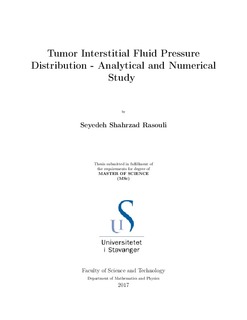| dc.contributor.author | Rasouli, Seyedeh Shahrzad | |
| dc.date.accessioned | 2018-05-16T11:35:47Z | |
| dc.date.available | 2018-05-16T11:35:47Z | |
| dc.date.issued | 2017-11-27 | |
| dc.identifier.uri | http://hdl.handle.net/11250/2498400 | |
| dc.description | Master's thesis in Mathematics and Physics | nb_NO |
| dc.description.abstract | Cancer is one of the deadliest diseases in the world and although huge research efforts have been applied to improve survival rates, there are still great challenges in treatment of the disease. Many factors contribute in the process of drug delivery and its absorption in tumor cells. Inside the tumor, the high interstitial fluid pressure (IFP) is one of the main barriers for drug penetration. In this work, interstitial fluid pressure is analytically investigated for homogeneous (without necrotic core) and heterogeneous (with necrotic core) tumor by considering the periphery region as a region between necrotic core and tumor edge. This is performed by adjusting a constant value of interstitial hydraulic conductivity for tumor and a lower constant value of interstitial hydraulic conductivity for normal tissue. Then, we focus on a heterogeneous tumor surrounded by normal tissue with the categorization of the necrotic core, periphery and intermediary regions and analytically investigate the tumor interstitial fluid pressure distribution for periphery and intermediary regions in some limiting cases. As the interstitial fluid pressure deeply correlates with the interstitial hydraulic conductivity, for further investigation, it is assumed that the interstitial hydraulic conductivity adopts a constant value in the central region and normal tissue; while it is changing radially continuously throughout the periphery and intermediary regions. In order to study such problems, more generally it is necessary to apply numerical methods. The numerical approach used in this work helps to investigate the tumor interstitial fluid pressure distribution for all regions. The effect of the necrotic core size on the maximum interstitial pressure is investigated. Moreover, the influence of the sizes of periphery and intermediary regions is inquired. From our numerical simulations, it is found that the abundance of blood vessels inside the periphery region influences the distribution of the interstitial fluid pressure; in such a manner that, increasing numbers of well-functional blood vessels causes a higher maximum value of the interstitial fluid pressure. A better understanding of interstitial fluid pressure distribution within a tumor, and methods to describe this in numerical terms, can be used in combination with imaging tools in order to gain insights in cancer cells aggressiveness and treatment planing. We also consider a more real model of a tumor where an asymmetric distribution of blood vessels is considered by including areas with variable arterial hydraulic conductivity in the periphery region. In this situation, the maximum interstitial fluid pressure is not observed in the center of the tumor, unlike the symmetric cases. | nb_NO |
| dc.language.iso | eng | nb_NO |
| dc.publisher | University of Stavanger, Norway | nb_NO |
| dc.relation.ispartofseries | Masteroppgave/UIS-TN-IMN/2017; | |
| dc.subject | kreft | nb_NO |
| dc.subject | svulster | nb_NO |
| dc.subject | væsketrykk | nb_NO |
| dc.title | Tumor Interstitial Fluid Pressure Distribution – Analytical and Numerical Study | nb_NO |
| dc.type | Master thesis | nb_NO |
| dc.subject.nsi | VDP::Mathematics and natural science: 400 | nb_NO |
